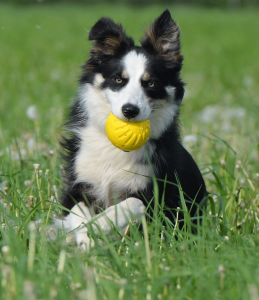If you’ve ever had the pleasure of seeing a bunny ‘binky’, you will know that it’s hard to beat. The leap and twisting of their body is a sign of pure enjoyment and it’s a true delight to witness. We want bunny ‘binkying’ to be a regular feature in your rabbit’s life, so we’ve got some advice to help them enjoy life to the full.
Imagine being locked in your home and garden, with just the odd trip out to a friend’s house a couple of times a week. Then imagine having no television or radio or anything to keep you occupied. Similarities can be drawn in keeping rabbits cooped up with nothing to play with and no real change to their surroundings, and rabbits can become bored and depressed. So unless they have acres to roam in safety (and let’s face it most of us can’t afford them that luxury), then guess who they will rely on as their source of entertainment? That’s right, you! Quite the responsibility, but don’t panic, we have some handy tips to get you started.
Firstly, make your job easier; give your rabbit as much space as possible for their home. As a minimum, a pair of medium sized rabbits should have an enclosure of 3 x 1 x 1 metres in size. They require at least an uninterrupted three metre length to run and play naturally, as well as a sleeping area. The height of a rabbit enclosure is often overlooked, because their shape is seemingly low to the ground. Rabbits will stand on their hind legs and they must have provision to do so for the health of their skeleton and muscles. With the basics in place, why not also consider whether they can be let out in the garden for a really good explore every now and then. Obviously not recommended unless your garden is enclosed and supervising them is the only way to be sure they’re safe from predators such as cats and dogs and foxes.
Now the real fun starts! There are all sorts of novel ways you can provide enrichment to your rabbits’ lives, let’s first consider toys. Never underestimate your rabbit’s desire to play. They are full to the brim with character; you just need to press the right buttons to expose it, something which you will find very rewarding. Rabbit toys are available to buy in abundance these days, from balls that they love to push and throw, to activity toys where they must find the hidden treat. But you needn’t spend lots of money, sometimes the simple things in life are the best – consider making your own. A toilet roll stuffed with hay and other treats can provide hours of entertainment.
How about stringing a ‘washing-line’ across their cage and pegging various delights all the way along? Don’t forget furniture too. In the wild a rabbit is used to jumping over logs and roots, and burrowing and tunnelling. So provide platforms and tunnels for them to re-enact this natural behaviour. You will encourage them to run and jump and duck and scurry, and it will do them the world of good. Take food foraging one stage further and recreate ‘the wild’ by spreading their food around the enclosure. Hide pieces of carrots as a treat (not daily), in different areas and make them work for it a little.
Entertaining your rabbits can massively increase the bond between you. Take the time to handle them, stroke and massage them and also take the opportunity to check them over for health concerns. If your rabbit isn’t used to being handled then start slow and with short sessions. Human interaction will really break up your rabbits’ day and give you the opportunity to enjoy them as a pet. Consider teaching them some tricks – rabbits can learn a surprising number of party-tricks, from jumping through hoops to running through tunnels. If you’ve ever seen rabbits ‘show-jumping’ you’ll know it’s a sight to behold. If not, then you must Google it! Always ensure training methods are positive and reward based to further increase the bond.

